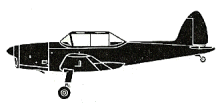
ASN Wikibase Occurrence # 69417
This information is added by users of ASN. Neither ASN nor the Flight Safety Foundation are responsible for the completeness or correctness of this information.
If you feel this information is incomplete or incorrect, you can submit corrected information.
| Date: | Thursday 26 August 1993 |
| Time: | 12:03 |
| Type: |  de Havilland Canada DHC-1 Chipmunk T.10 |
| Owner/operator: | 6 FTS RAF 6AEF Coded 'E' |
| Registration: | WP980 |
| MSN: | C1/0846 |
| Fatalities: | Fatalities: 1 / Occupants: 2 |
| Aircraft damage: | Destroyed |
| Category: | Accident |
| Location: | RAF St. Athan -
 United Kingdom United Kingdom
|
| Phase: | Initial climb |
| Nature: | Private |
| Departure airport: | EGDX |
| EGDX | |
| Confidence Rating: |
That afternoon, the aircraft took off from RAF St. Athan for an air experience flight. Shortly after take-off, the aircraft was seen to climb steeply to about 250 ft, whereupon the engine noise died. Witnesses then observed the aircraft to pitch up and turn sharply left (a wingover) before descending on a reciprocal track and impacting the ground adjacent to some hangars.
Shortly before impact, engine power was restored. The aircraft was badly damaged and the pilot, in the front seat, was killed. His passenger was promptly rescued by the airfield crash rescue services and taken to hospital with major injuries.
The pilot was a retired senior officer serving with the Royal Air Force Volunteer Reserve, and his passenger a civilian ground instructor from an Air Training Corps Squadron attending a summer camp on the station. The passenger was subsequently unable to recall events surrounding the accident.
The Board of Inquiry reasoned that the pilot had intended to demonstrate an emergency that culminated in a practice forced landing; the failure would be simulated by throttling the engine back to idle. Shortly after take off the pilot transmitted to Air Traffic Control that he was simulating an engine failure.
Following the call, the standard practice would have been for the aircraft to descend ahead, in a direction within 30 degrees either side of the runway heading, before climbing away from a height not below 100 ft. Since the aircraft did not follow the expected profile, the Board deduced that the pilot had either badly mishandled the exercise or that he had deliberately initiated a non-standard turn back towards the airfield.
In either event, the Board concluded that the pilot had stalled the aircraft with insufficient height in which to effect recovery. However, since the Board could not be sure that the engine had not suffered a short-term power loss, they could not attribute negligence to the pilot.
CAUSE: The most probable cause of the accident was that the pilot initiated a steep, tight wingover from a low height, mishandled the aircraft, including closing the throttle, thus placing the aircraft in a position from which there was insufficient height to recover.
SUBSEQUENT ACTIONS: Regulations have been reviewed to improve the supervision of air experience flying. Investigations are in hand to determine if crash survivability of light aircraft can be improved.
Sources:
http://www.mod.uk/NR/rdonlyres/66D5011C-873D-4C34-89F9-E95E30A3045A/0/maas93_01_chipmunk_tmk10_wp980_26aug93.pdf
http://www.ukserials.com/losses-1993.htm
https://abpic.co.uk/pictures/view/1067245/_
http://ciapoldiescorner.blogspot.co.uk/2009_08_01_archive.html
Newcastle Journal 27,8,93
Revision history:
| Date/time | Contributor | Updates |
|---|---|---|
| 25-Oct-2009 11:26 | andrewaircraft | Added |
| 25-Oct-2009 12:10 | andrewaircraft | Updated |
| 07-Nov-2011 12:54 | Dr. John Smith | Updated [Time, Operator, Source, Narrative] |
| 19-Feb-2012 01:27 | Lulu | Updated [Time] |
| 09-Mar-2013 03:25 | Anon. | Updated [Narrative] |
| 23-May-2013 15:38 | Dr. John Smith | Updated [Source, Narrative] |
| 20-Nov-2014 13:38 | Dr. John Smith | Updated [Embed code] |
| 20-Nov-2018 17:50 | Nepa | Updated [Operator, Operator] |
| 31-Mar-2020 08:07 | rod brown | Updated [Operator] |
| 31-Mar-2020 08:07 | harro | Updated [Operator, Source] |
Corrections or additions? ... Edit this accident description
The Aviation Safety Network is an exclusive service provided by:


 ©2024 Flight Safety Foundation
©2024 Flight Safety Foundation